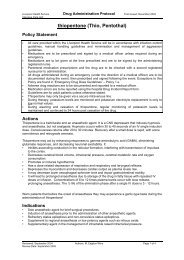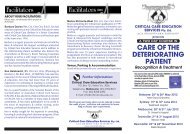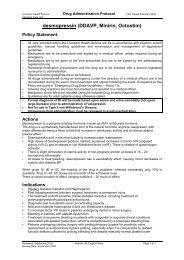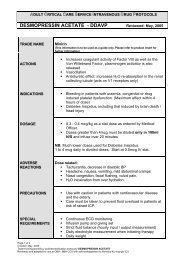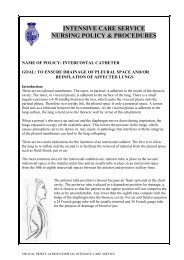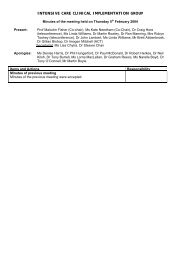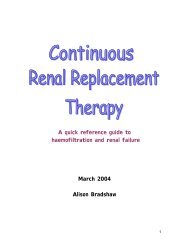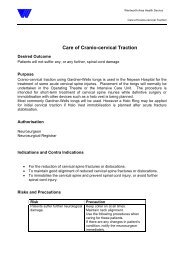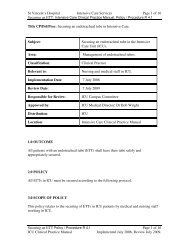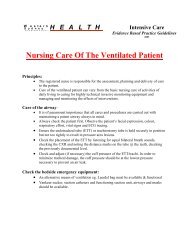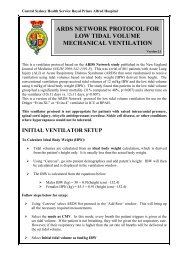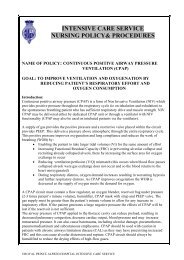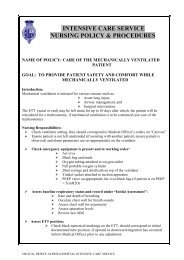Stabilisation of an Endotracheal Tube for the Adult Intensive Care ...
Stabilisation of an Endotracheal Tube for the Adult Intensive Care ...
Stabilisation of an Endotracheal Tube for the Adult Intensive Care ...
Create successful ePaper yourself
Turn your PDF publications into a flip-book with our unique Google optimized e-Paper software.
Table 1: Recommendations <strong>for</strong> Practice<br />
Number Statement<br />
1a<br />
1b<br />
1c<br />
2<br />
2a<br />
2b<br />
2c<br />
3<br />
4<br />
Two clinici<strong>an</strong>s must always be present to ch<strong>an</strong>ge <strong>the</strong> method <strong>of</strong> securing<br />
<strong>the</strong> endotracheal tube. One clinici<strong>an</strong> ch<strong>an</strong>ges <strong>the</strong> tapes while <strong>the</strong> o<strong>the</strong>r<br />
holds <strong>the</strong> ETT in position.<br />
Of <strong>the</strong> two clinici<strong>an</strong>s ch<strong>an</strong>ging <strong>the</strong> ETT securement at least one clinici<strong>an</strong><br />
must be <strong>an</strong> experienced member <strong>of</strong> <strong>the</strong> critical care team.<br />
The method <strong>of</strong> stabilisation should be consistent within units to promote<br />
staff pr<strong>of</strong>iciency in safe <strong>an</strong>d effective ET stabilisation.<br />
The methods <strong>for</strong> securing <strong>an</strong> ETT c<strong>an</strong> be divided into 3 groups: twill tape;<br />
adhesive tape <strong>an</strong>d m<strong>an</strong>ufactured devices. There is minimal research<br />
evidence to support <strong>the</strong> use <strong>of</strong> <strong>an</strong>y one method over <strong>the</strong> o<strong>the</strong>r two.<br />
However, <strong>the</strong>re are principles that c<strong>an</strong> in<strong>for</strong>m this decision.<br />
The use <strong>of</strong> adhesive tape/devices should be avoided in patients with<br />
impaired facial skin integrity (<strong>for</strong> example burns, cellulitis).<br />
The use <strong>of</strong> adhesive tape/devices should be avoided in patients with<br />
extreme diaphoresis.<br />
The use <strong>of</strong> adhesive tape/devices should be avoided in male patients with<br />
beards.<br />
<strong>Endotracheal</strong> tube securing methods that may cause venous occlusion<br />
should be avoided <strong>for</strong> patients at risk <strong>of</strong> raised intracr<strong>an</strong>ial pressure<br />
There is minimal research evidence to support <strong>the</strong> frequency <strong>of</strong> renewal <strong>of</strong><br />
ETT stabilisation methods. However <strong>the</strong>re are principles that support <strong>the</strong><br />
decision about frequency.<br />
4a The ETT securing method should be renewed if <strong>the</strong> tapes are soiled.<br />
4b<br />
4c<br />
4d<br />
4e<br />
4f<br />
5<br />
6<br />
The ETT securing method should be renewed if <strong>the</strong> ETT is able to<br />
migrate/move more th<strong>an</strong> 1 cm.<br />
When using cotton tape <strong>the</strong> ETT securing method should be renewed if a<br />
clinici<strong>an</strong> is unable to insert two fingers between tape <strong>an</strong>d skin.<br />
The ETT securing method should be renewed if <strong>the</strong> ETT position on CXR is<br />
incorrect (tip should be 2.5cm above <strong>the</strong> carina).<br />
The ETT securing method should be renewed if <strong>the</strong> method <strong>of</strong> tube<br />
stabilisation is not consistent with Unit practice.<br />
In <strong>the</strong> absence <strong>of</strong> o<strong>the</strong>r indications <strong>the</strong> tube stabilisation method should be<br />
renewed at least once every 24 hrs to enable skin <strong>an</strong>d mucosal<br />
assessment <strong>an</strong>d to prevent sustained pressure on a single point.<br />
Assessment <strong>of</strong> <strong>the</strong> face should include <strong>the</strong> condition <strong>of</strong> <strong>the</strong> skin <strong>of</strong> <strong>the</strong> face,<br />
ears <strong>an</strong>d back <strong>of</strong> neck. In addition <strong>the</strong> assessment <strong>of</strong> <strong>the</strong> oral cavity<br />
should be inline with <strong>the</strong> assessment completed <strong>for</strong> adequate oral hygiene<br />
<strong>an</strong>d includes <strong>the</strong> mouth, teeth, gums, tongue, mucous membr<strong>an</strong>es, lips<br />
<strong>an</strong>d barriers to mouth care.<br />
The ventilator tubing should be supported by a ventilator arm that keeps<br />
<strong>the</strong> patient’s head in <strong>the</strong> midline <strong>an</strong>d prevents pressure on <strong>the</strong> lips.<br />
6<br />
Grade <strong>of</strong><br />
recommendation<br />
Consensus<br />
Opinion<br />
Consensus<br />
Opinion<br />
Consensus<br />
Opinion<br />
Consensus<br />
Opinion<br />
Consensus<br />
Opinion<br />
Consensus<br />
Opinion<br />
Consensus<br />
Opinion<br />
Consensus<br />
Opinion<br />
Consensus<br />
Opinion<br />
Consensus<br />
Opinion<br />
Consensus<br />
Opinion<br />
Consensus<br />
Opinion<br />
Consensus<br />
Opinion<br />
Consensus<br />
Opinion<br />
Consensus<br />
Opinion<br />
Consensus<br />
Opinion<br />
Consensus<br />
Opinion




